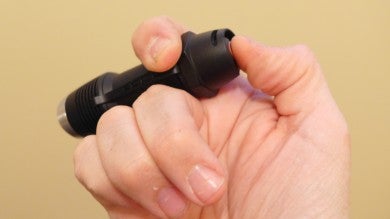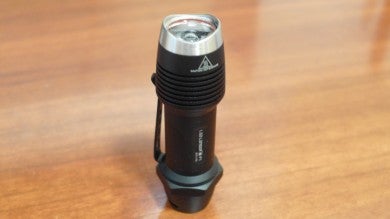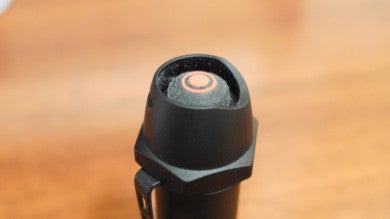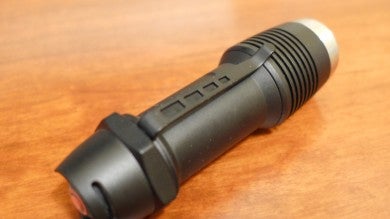LED Lenser F1 Review
Tony Sculimbrene 11.12.13
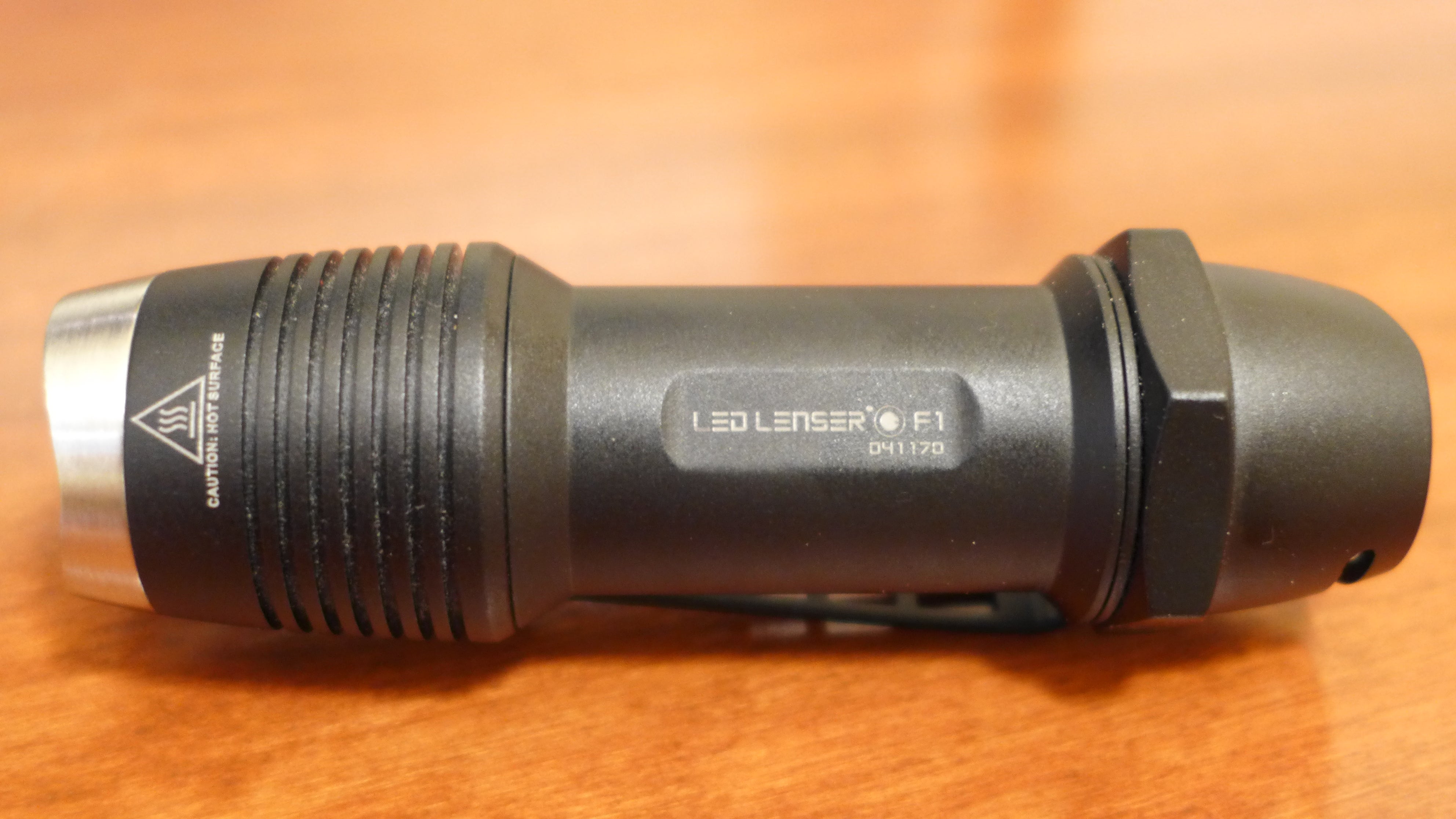
There is one night a year when flashaholics come out and show off their wares, one night when an obsession with flashlights doesn’t seem like a waste of money but a boon (everyone always pokes fun – until the power goes out). That night is Halloween. Each year I actually have a little debate going on in my head as to which light I will use in the run up to trick or treating. Thus far the McGizmo Haiku has won every year. This year, because I was testing out the LED Lenser F1, there was no debate. In this most crucial of tests, illuminating my son’s trip from candy giver to candy giver, all while dressed as a hard to see 3 foot tall Kung Fu Panda, the F1 passed with flying colors. It’s an amazing performer in a great body, but it has two flaws. The flaws aren’t fatal, but they are something you need to know about before you drop some dough on the light.
Description
Here is the product page for the F1. (Note to LED Lenser: the specs section needs to say if the output is regulated or not; it is, despite the lack of information). The F1 is a 1xCR123a light that uses a total internal reflector instead of a normal mirrored dome. The TIR is an optics based system, using ground lenses to shape and clean up the light sent out by the emitter. This lens grinding is a specialty of LED Lenser, one of their hallmarks, and it makes for a great system.
The light is roughly three and half inches long and one inch in diameter. It comes with both a normal bezel and a tactical “strike” bezel. I actually prefer the strike bezel, as the light can stand vertically on either end when the strike bezel is installed. The light has a washer style pocket clip that can be reversed for either bezel down or bezel up carry. The light comes with a lanyard, a cleaning cloth for the lens, and a small brush.
Overall, the light has a wide head and tail with a narrow center portion. It allows for an amazingly stable grip on the light (using the so called cigar grip).
There is a hex ring on the rear portion of the light. Both the hex ring and the clip act as anti-roll devices. The clicky is excellent, and there is small scoop in the tailcap to funnel your thumb to the click. This is a forward clicky. The entire body is made of aluminum, and it has been coated with black Hard Anodization III.
Testing
In addition to escort duties on Halloween, the F1 was my EDC light for about three weeks of normal chores. I cleaned out my house for fall in those three weeks, crawling into small dark spaces and into the room in our house that holds our oil tank. There is a lot of muck and dirt in these places, and the F1 did well. It’s hard to overstate just how good the optics are here as the light provided consistent and useful illumination even in pretty dank conditions. The lens is largely the reason why.
I also used the light as a nightstand light. It did very poorly in this role for reasons I’ll explain below.
Design
Overall, the F1 is a very well built light, far ahead of the midrange lights like those made by 47s, Jetbeam, and Olight. The the feel of the light is much closer to SureFire lights than anything else, and in many ways I think it is superior. LED Lenser, a German company now owned by Leatherman, was aided in the design of the F1 by the folks over on Taschenlampen Forum, a German counterpart to CPF.
Having recently reviewed the SureFire EB1, their standard bearer 1xCR123a light, I can tell you I prefer the shape and size of the F1. It is much more compact and more comfortable in the hand thanks to the narrow center section and the hex ring. I also think the small cut out in the rear of the light is ingenious, a brilliantly simple solution that seems to have vexed makers for a long time. Everyone wants to make a light with a clicky that is easy to reach and that can still tailstand. Few can really nail this. The F1 does.
As rendered on paper, there are very few things to complain about the F1. It is an awesome little light.
Implementation
Implementation is another story.There are two flaws (neither of which are fatal and both of which are easy to fix) that would transform this light from contender to king in the 1xCR123a market segment.
First, the UI is messed up for an EDC light. Part of this could be a preference difference between US and German flashaholics. It could also be that LED Lenser intends the F1 to be a strictly tactically light, and in that role the high should probably be first. This second argument is buttressed by evidence: the F1 takes only primary cells, a common trait among tactical lights. That said, I think this is a mistake.
The EDC role is much more common, and many companies, Surefire included, solve this problem by making two models with different UIs. It’s not complicated. A simple change to the circuit board would do the trick. The other way to address this is allow for a user selectable UI. The LED Lenser M7R does this, so it is both clearly possible and within the range of possibilities for LED Lenser.
Second, the low is simply too bright. At 60 lumens, it will rob you of your night vision and wake up the neighbors. It was excellent for use during walks – bright enough to chase away shadows but not so bright that your light melts down. It just shouldn’t be the low. Instead, it should be the medium on this light.
Those two cons aren’t bad because they are balanced out by the pros. This light kills it on high, hitting 400 lumens on a single primary cell. No other light in its class comes close. Additionally, the beam pattern is positively beautiful. Compared to the TIR beam on the EB1, the F1 has a real and useful spill and equally few artifacts, leading me to prefer the F1. Beating SureFire in the beam profile department is a true accomplishment, and that’s something no other production maker has done in my opinion.
Function
The pocket the light’s excellent clip and small size make it an easy carry.
Its not as easy as a 1xAAA light, and I prefer that form factor over this one, but the output differences are staggering and probably enough to make up the difference. The anti-roll features work flawlessly, and the light tailstands like a statue. Around the house and outside at night, the F1’s very substantial high gives you more light than you could ever reasonably need unless you do search and rescue. In the house, it is just too bright, even on low.
Its quite an impressive feat to make a light that rivals a SureFire. So far, many of the mid range brands have tried to out-feature and out-lumen SureFire, but no one has really been able to run with them in terms of design and utility. The F1 does that and does it at a significantly lower price (the F1 retails for $80, and the EB1 costs $225). With a lower low and an improved UI, the F1 would be the undisputed king of the 1xCR123a market. As it is, it might be time for a Flashlight Thunder Dome between the F1 and the EB1. Two flashlights enter, one flashlight leaves.
